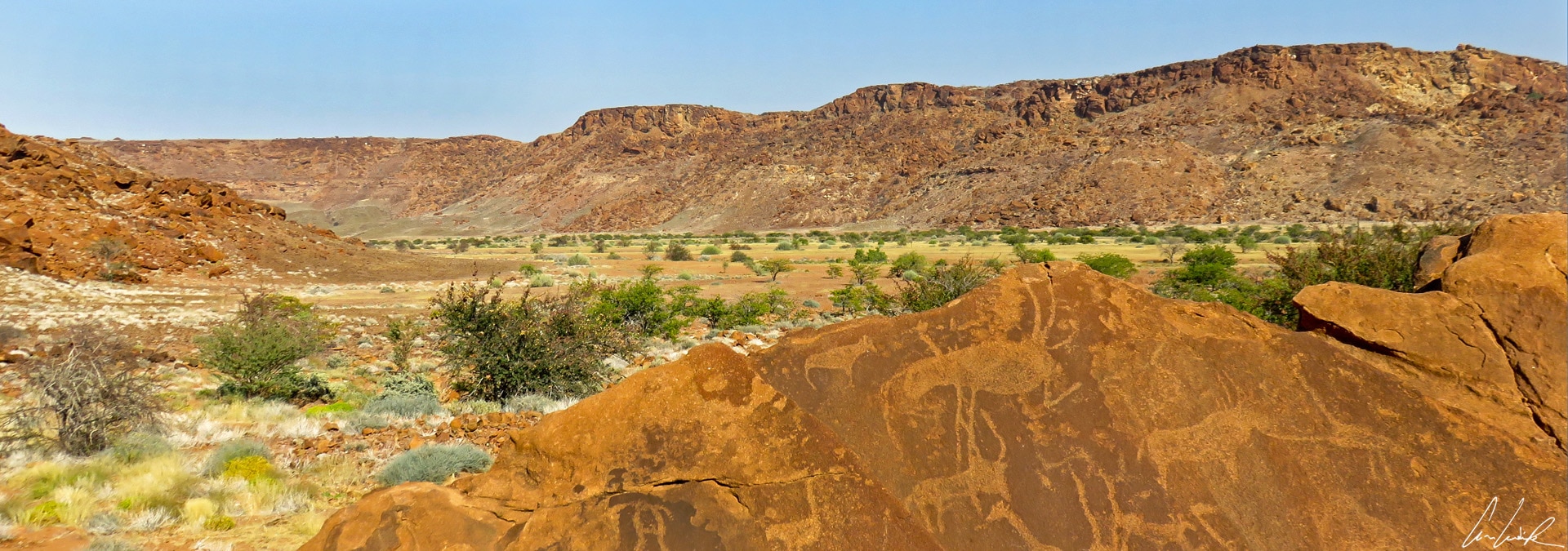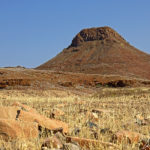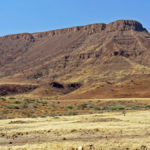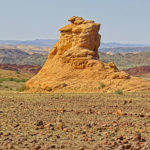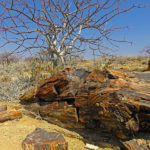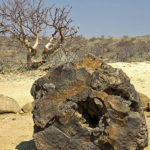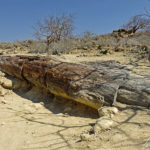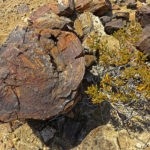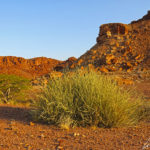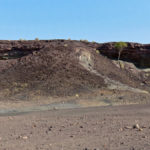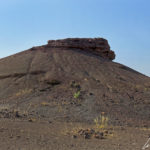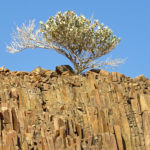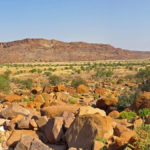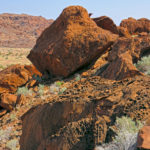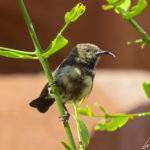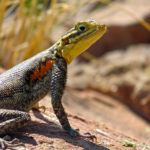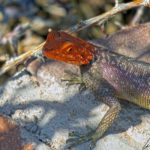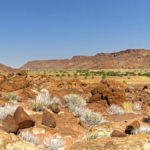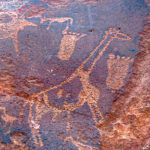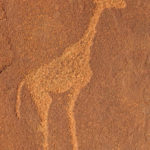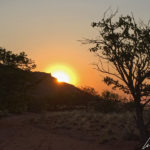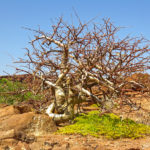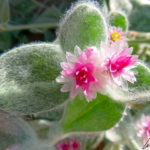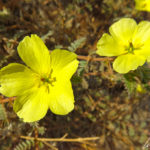Let’s continue « Travelling Through The Wild Side » to the reggae music of Namibian musician Ras Sheehama and discover Damaraland, through its art and geology…
« Travelling through the wilderness / I keep on travelling and travelling… / Through the wilderness »
(Travelling Through The Wild Side – Ras Sheehama)
Located in the northwestern part of the country between the Skeleton Coast and Kaokoland, Damaraland is one of the wildest regions of Namibia. Its rusty and orange landscapes alone are worth a visit. With its vast endless expanses, its canyons, its vibrant colors, and its countless engravings and rock paintings inherited from hunter-gatherers, Damaraland offers a beautiful and peaceful view of nature. When South Africa ruled Namibia in the 1970s and enforced Apartheid, the name Damaraland was given to a Bantustan, a self-governing homeland for the Damaras people. Damaraland, like the other homelands in Southwest Africa, was abolished in May 1989 at the beginning of the transition to independence. The Damaras speak a language with “clicks” combining speech with taps of the tongue against mouth and palate. If you want to impress your friends, say “hello, how are you” in Damara, “!Gâi tses. Matisa”. In writing, the exclamation mark (!) is used to indicate a “click” in a word. Come on, get started, and don’t just stand there petrified like a tree trunk…
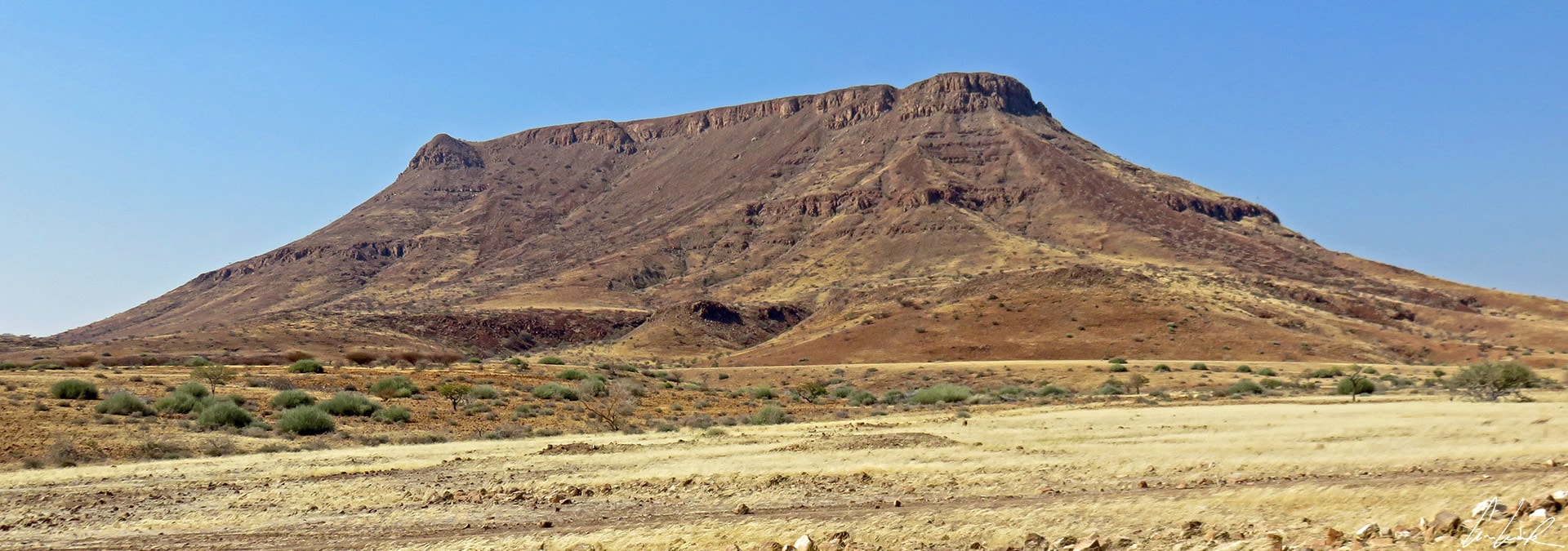
The Petrified Forest of Damaraland
Located about 26 miles west of Khorixas, the Petrified Forest was discovered in the 1940s by two farmers. The site, declared a National Monument on March 1, 1950, covers about 20 hectares in the valley of the Anabib River. The name is a bit misleading as it is not exactly a forest, which turned to stone, but rather an accumulation of fossil tree trunks. This vast fossil forest is about 280 million years old (dating from the heyday of the Gondwana continent. We believe that the trees were swept down a river by a great flood and then covered by alluvial sands. At least that is what the absence of roots and branches suggests ! The flood carried sand and mud, which covered the trees to such an extent that air was kept out and consequently no decay took place. The organic material of the trunk was conserved and became fossil, keeping the appearance of wood. Geologists have done some research on the trunks and found out that the trees belong to the Cordaïtes family, ancestors of firs and spruces.

The site is relatively small (nothing comparable to the Petrified Forest National Park in Arizona.) After years of erosion, about fifty trunks, some half-buried in sandstone, are now exposed. The largest trunk is about 130 feet long, and the widest four feet in diameter and 33 feet long. Petrified wood preserves fairly completely the original anatomical structure of the wood… adding nuances of color depending on the minerals that have infiltrated the wood over the centuries. The process of petrification in silica has preserved many branches intact. The bark and rings of the wood are still clearly visible, but to the touch it is stone, hard and heavy ! If these trunks could tell us their story, they would probably take ownership of the line by the Belgian surrealist poet Louis Scutenaire:
« Being a statue during your lifetime makes you petrified »
(Mes inscriptions – Louis Scutenaire)
In the midst of this chaos, Namibia’s national plant, Welwitshia Mirabilis, covers the ground with its long leaves. Welwitshia Mirabilis was named after German botanist Friedrich Welwitshia who discovered the plant in the mid-19th century. It is a kind of living fossil as it is very long-lived, but appears to be a “young” lady in comparison to the petrified tree trunks that are several million years old.
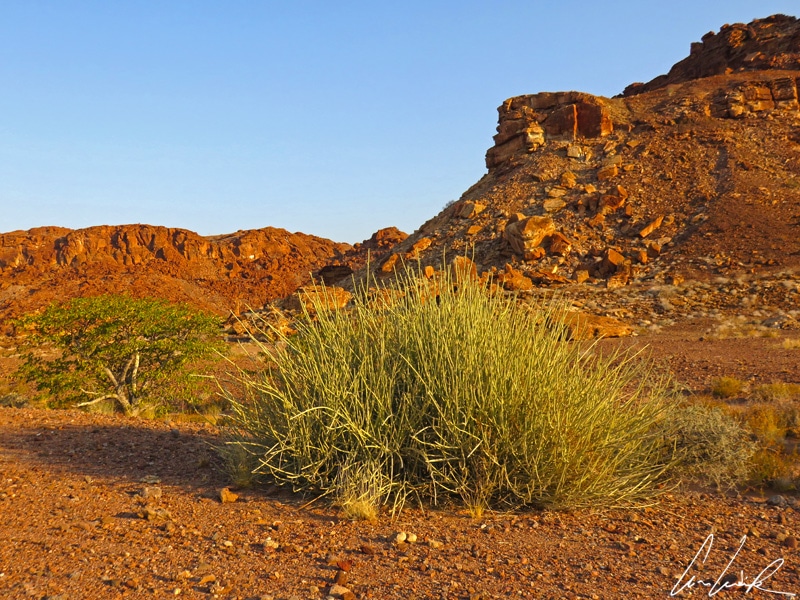
Basalt organs and the Burnt Mountain, for geology enthusiasts
The landscapes of Damaraland are astonishing. Red mountains rise from the desert and then, at the end of an unpaved road, you find a black, gloomy, and desolate landscape where almost nothing grows. Burnt Mountain is a 650-foot high hill that is part of a volcanic chain that stretches for about 6 miles southeast of the Twyfelfontein valley. The clays (remains of ancient glacial lakes) have been wholly baked and then annealed after a boiling lava flow (over 1832°F) creating this particularly lunar landscape. The Mountain was literally burned and then compressed during this metamorphosis ! Nothing, or almost nothing, grows in the middle of this mass of slag…
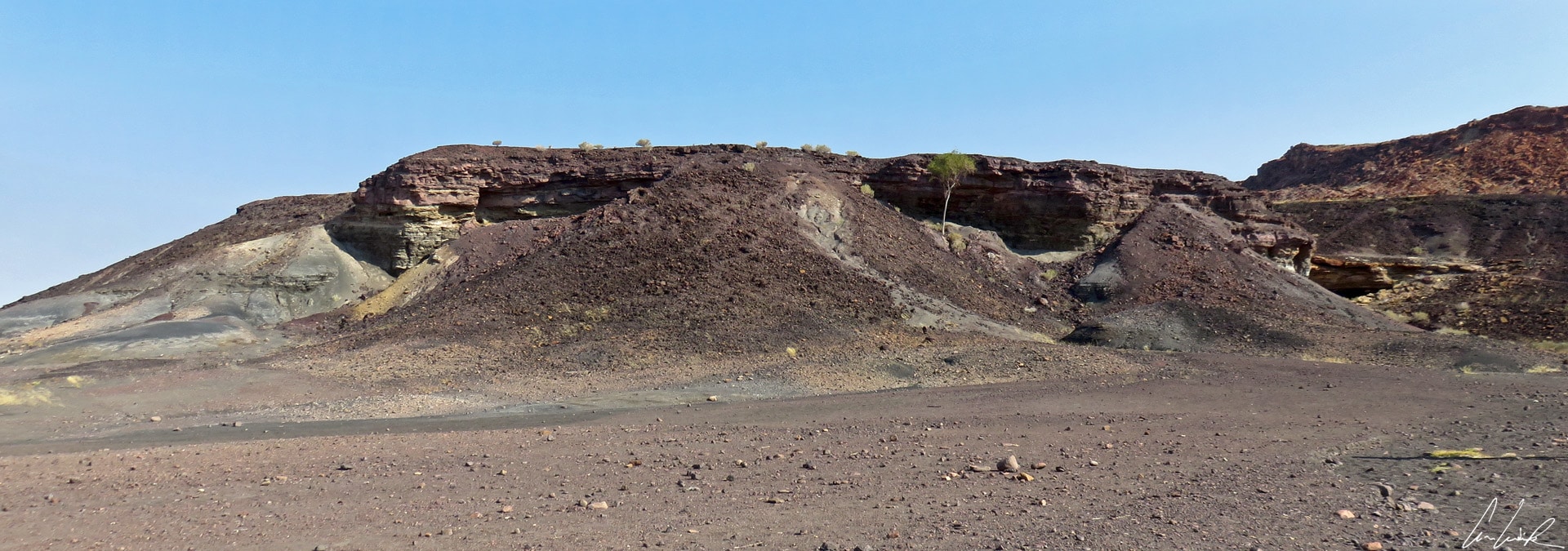
The highlight of the day is another fascinating geological curiosity near the inselberg of Burnt Montagne: the so-called Organ Pipes. A small canyon of about 320 feet with a group of Dolerite pillars (magmatic rocks intermediate between basalt and gabbro) aligned to form a multicolored wall.
« Giant are these walls built of stone and blood
Higher than battles, defying the weight of years »
(Les Murailles – Jean-Jacques Goldman)
Their shape resembles a bit the pipes of a church organ… hence their name. Some columns were formed about 120 million years ago and reach a height of 13 feet. Their regular hexagonal structure, the result of the slow cooling of lava flows as they turned into slate, can surprise the visitor. These igneous rock formations add some fascinating structure to the landscape. The composition of the organ pipes has been studied for years by scientists conducting laboratory experiments using models made of corn starch and water… You are free to try them out in your kitchen with a little corn starch to verify the geological theory of this hexagonal structure !

History of Twyfelfontein
The Twyfelfontein valley is a mysterious and must-see site in Namibia. In Afrikaans its name means “uncertain spring”. This archaeological site displays one of the largest concentration of petroglyphs in Africa. In 2007, the Twyfelfontein valley was listed UNESCO World Heritage Site. Twyfelfontein is located about 44 miles west of the city of Khorixas in Damaraland. Twyfelfontein is equivalent to the Vallée des Merveille in the Mercantour National Park in Southeastern France, an open-air museum with some 2000 listed rock engravings. Stone-age hunter-gatherers inhabited the Twyfelfontein valley 6000 years ago. They made most of the engravings and probably most of the paintings. They knew Twyfelfontein as “/ Wi // Aes,” which means “a place among the stone” in the Damara language. And the name is not made up… the site contains huge blocks of sandstone, where mopanes, bosquias albitronea (or shepherd’s tree) and small clumps of petalidium grow. The San, who were the first inhabitants of the Twyfelfontein Valley, are considered to be the authors of prehistoric works of art.
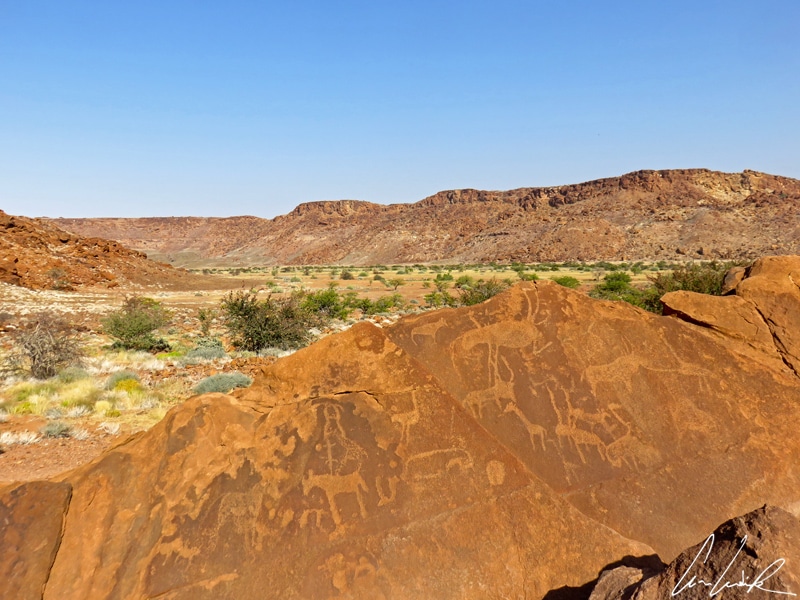
In 1946, David Lewin (the first white settler) arrived with his cattle, personal belongings and family (a wife and five children). Today, the ruins of their farm are still visible on the site. He named his farm “Twyfelfontein” because of his constant struggle for water, essential for the survival of both his livestock and family. When water flows in the stream, life flows all around. The Amethyst sunbird twirls while a couple of Agama agama, also known as red-headed rock agama or rainbow agama, enjoy the sun. The male wears his most beautiful orange-blue color. But it was David against Goliath… and Goliath finally won, contrary to the myth in the Bible (the most widely read book of all time – 40 million copies a year, making Jesus… a god of marketing, no? The drought finally forced David and his family to leave Twyfelfontein and move to an area more suitable for grazing. “Gâise !gûre” (Goodbye)… Practice your “click”.

The rock paintings of Twyfelfontein: seen through the eyes of a shaman…
Located on a rocky spur and surrounded by sandstone boulders the Twyfelfontein valley has one of the highest concentrations of rock art on the African continent. In the heart of the ochre mountains of Damaraland, these ancestral artworks are immortalized on red stone blocks. Made with quartz tools on sandstone, most of the works are well-preserved thanks to the dryness of the climate. If you have an archaeologist’s soul and are ready to follow in the footsteps of Indiana Jones or Lara Croft, this is where your investigation begins… A most exciting treasure hunt! But beware, in this case your investigation will not lead to fabulous treasures, mountains of gold and jewelry, statues encrusted with precious stones—the stuff of the stories of these fictional archaeologists !
« Archaeology and detective work weren’t that dissimilar. They were both about following clues, analyzing evidence, solving mysteries. The only real difference was that while the archaeologists tended to unearth wonderful things, it was the detective’s lot, more often than not, to find terrible ones »
(The Lost Army of Cambyses – Paul Sussman)
In Twyfelfontein, all the African animals are represented: giraffes and rhinos, oryx, kudu, zebras, and ostriches. The representation of a sea lion and a penguin would suggest some contact between the Bushmen and the coast, even though it is more than 60 miles away ! Also, there are footprints of men and animals as well as topographical evidence showing the location of the valley’s water springs on the stone. But beyond these representations of “ordinary” scenes of everyday life from the late Stone Age – wild animals, hunting scenes and even water sources – the artist or artists also wanted to convey shamanic messages…
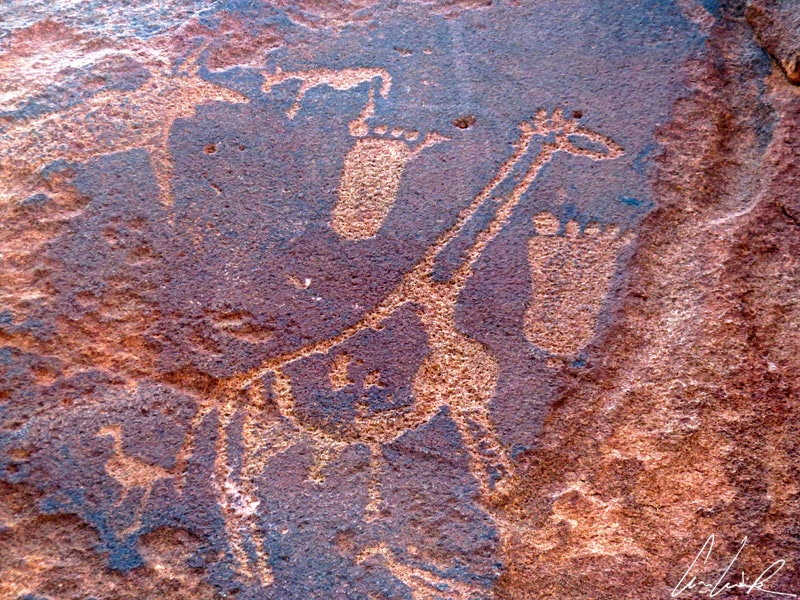
Take, for example, the giraffe, which is very frequently represented in the rock art of Twyfelfontein. It is typically shown without heaviness, its legs shaped into long thin lines. The giraffe gives the sensation of effortlessly rising into the air, similar to the excitement felt by the shaman in a trance. Sometimes the giraffe’s body is totally deformed, which corresponds to the moment when the shaman feels his shape changing… Once the shaman has been transformed, the giraffe will be represented with five protuberances on its head, corresponding to the five fingers of the hand. Similarly, the engraving of the “lion-man” shows five fingers on each paw when in reality a lion has only four. The deliberate combination of human and animal characteristics shows that it was a shaman who changed into a lion. In the shamanic tradition, each animal in its own way will teach you its “medicine” by transmitting its lessons of Life… Now, it is up to you to find your Totem animal !
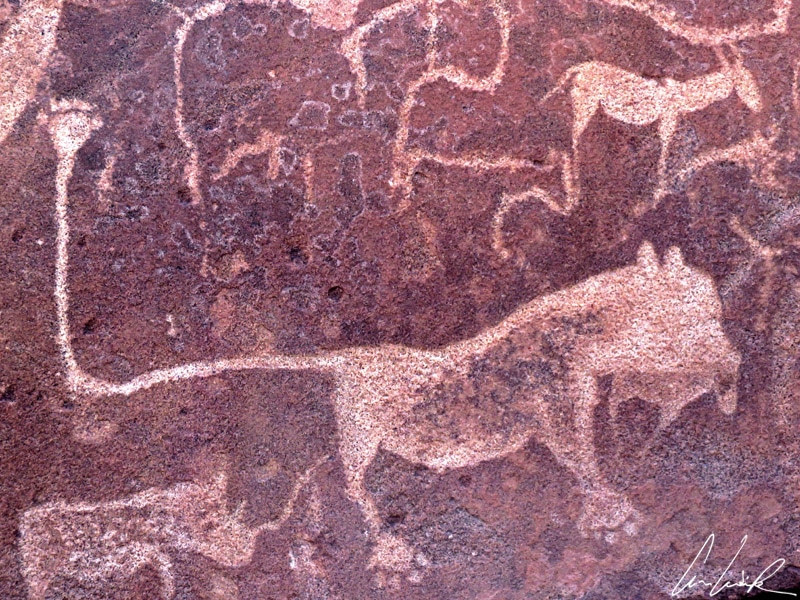
Twyfelfontein: for folks who are not passionate about archaeology
If you are immune to old engraved stones and shamanism, you still have the beauty of the natural setting punctuated by the sound of Kgala!Namib by the singer Elemotho. We never tire of admiring these mountains made of heaps of rock with strangely shaped trees that turn bright red at sunset. And always this endless savannah with its golden herbs… where you can sometimes see baboons in the middle of a meal. It’s most idyllic.
« Nature is only a show of kindness »
(A season in hell – Arthur Rimbaud)
However, keep on your guard, as the Sun begins its descent, dangerous wildlife roam the area. The Peringuey’s adder (Bitis peringueyi), commonly known as the Namibian desert viper, takes less than a minute to bury itself just under the surface. Only its eyes and the tip of its tail are exposed. The Bitis peringueyi is a small snake only about 10 inches long. The head is short and flat with its eyes on top. Ambush is its favorite hunting technique. It remains patiently buried, and when prey passes within its reach, it springs like a devil to bite the prey with vigor. Its venom, very toxic, kills the victim in a few minutes. Fortunately for you, Bitis peringueyi is sensitive to heat and not active during the day, only at dusk and at night…

As for flora, the Twyfelfontein site is also a real open-air pharmacopeia. The Brandberg acacia (Acacia montis-usti) is endemic to Namibia with its characteristic flat, spread crowns, which give the appearance of a feather duster, the castor oil trees (Ricinus communis), the shepherd tree (Boscia albitrunca), the camphor tree (Cinnamomum camphora), citronella, and Namibian Myrrh (Commiphora Wildii). Myrrh resin comes from the sap that flows like tears (milky or white-yellow) either freely or to fight potential bacteria after a wound to the bark of the shrub. The sap is traditionally called “Omumbiri” and has been used for many years by Himba women as a traditional perfume and also to protect the skin from the sun. Once in the open air, the sap hardens into irregular red-brown tears and gives a resin known as myrrh. This resin has a very bitter taste, but spreads a delightful aromatic fragrance. The name myrrh should also awaken your biblical knowledge since twelve centuries after Exodus, the body of Christ was embalmed, according to a usage borrowed by Jews from the Egyptians, with a mixture based on myrrh. The New Testament mentions myrrh and frankincense. The biblical magi, when they saw the infant Jesus in his crib, offered gold and myrrh. Myrrh and frankincense, also know to westerners as olibanum, are both aromatic resins. They are used in vast quantities in domestic and religious fumigation, balms, and scented oils. The Egyptians cleansed the body cavities in the mummification process with frankincense and natron; a technique that prevents the biodegradability of body and soul! Today, the perfume, cosmetic, and pharmaceutical industries use both myrrh and frankincense. The resin is collected during the hot, dry months when it is naturally exuded. The essential oil is obtained by steam distillation of the dry resin. In Chinese medicine, myrrh has antibacterial properties.
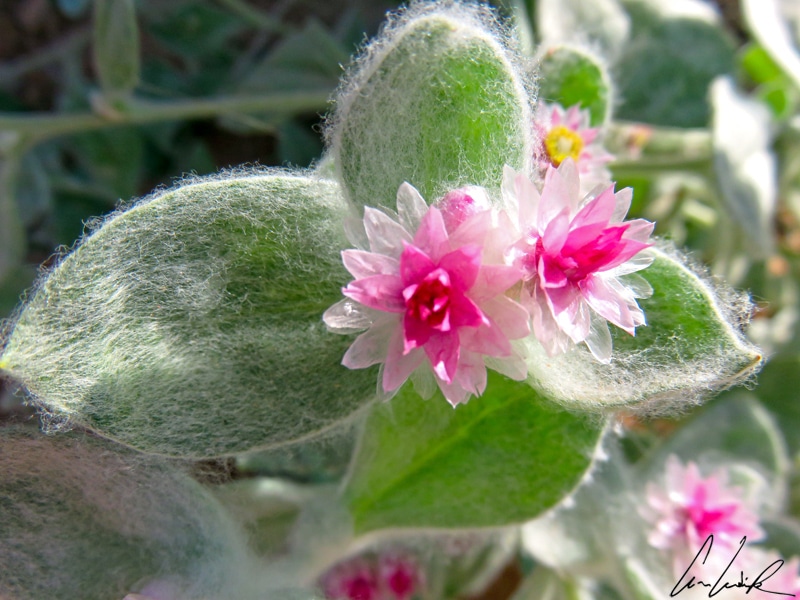
Besides a vast number of trees worthy of a 24-hour pharmacy, the Twyfelfontein valley also conceals very extraordinary little flowers… The whiteness of the South-west Edelweiss (Helichrysum roseo-niveum) contrasts with the reddish-ochre of the granitic rocks. The South-west Edelweiss is native to the Namib Desert. As beautiful as they are, these edelweiss are dangerous for animals and humans. They need to be handled carefully; otherwise, they can poison and lead to blindness, especially for small animals. However, local tribes use it for perfume. The plant’s leaves have a soft velvety down texture. We also find another widespread plant with long stems, crawling flush to the ground and extending over three feet in circumference. It is covered with yellow flowers. It is Tribulus zeyheri, a close relative of the Terrestrial Tribule or Maltese Cross (Tribulus Terrestris) that you may know because it has been said to have effects on libido, physical fitness and muscle mass gain (it is a natural anabolic.) In Europe, its negative reputation dates back to the early 1980s, when a team of Bulgarian weightlifters awarded it credit for their sporting performances. The first active ingredient of Tribulus is indeed protodioscin, which would be chemically very similar to DHEA, a steroid hormone with recognized effects. The Tribule is found in many traditional medicines around the world, in the Mediterranean basin, in Chinese medicine, and in India… It has been identified or attributed over the years with multiple benefits, including a diuretic, analgesic, anti-inflammatory, antibacterial, and of course aphrodisiac. But what is going on? Is Tribulus Terrestris a real asset for the natural athlete (or lover) in search of performance? Discover for yourself what this plant is capable of, or “Laedi aoba ǂgaire!” (Call a doctor).
Find more on Namibia
- Waterberg Plateau Park !
- Lake Otjikoto, a lake that digs its own hole !
- A glimpse of Etosha National Park
- In the heart of the Etosha National Park wildness
- Etosha National Park: A journey to the Animal Kingdom
- Epupa Falls: rendezvous in Himba land
- Encounter with Desert Elephants and Welwitschia Mirabilis
- The Mysterious Skeleton Coast, and Cape Cross’ Fur Seals
- Walvis Bay:Rendezvous with Desert and Ocean
